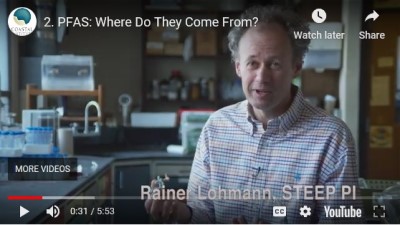Superfund Research Program
December 2019

Lohmann explains the chemical properties of PFAS that make them ideal for firefighting foams and persisting in the environment. He also describes how humans can be exposed to PFAS.
(Photo courtesy of the URI SRP Center website)
In an eight-part video series, Silent Chemicals, Loud Science, researchers at the University of Rhode Island Superfund Research Program Center (URI SRP Center), funded by NIEHS, share important information about per- and polyfluoroalkyl substances (PFAS). PFAS are commonly used in consumer products and firefighting foams and can accumulate in the environment.
"The problem with PFAS is once you produce them, they do not break down easily," said Center Director Rainer Lohmann, Ph.D. "We call them forever chemicals."
The URI SRP Center, Sources, Transport, Exposure, and Effects of PFAS (STEEP), is examining the health effects of PFAS exposure and pathways of contamination and identifying ways to reduce exposure. The videos explain what PFAS are and where they come from and how PFAS affect ecosystems and humans. Each short video features interviews with Center researchers and trainees to highlight research from STEEP.
For example, in the second video, Lohmann discusses how humans are exposed to PFAS through a wide range of manufactured goods, food products, and water supplies. STEEP researcher Angela Slitt, Ph.D., describes how PFAS can harm human health, including by contributing to obesity or liver problems. In part three, trainee Anna Robuck explains her research in seabirds and surface water from different coastal environments to understand how birds are exposed to PFAS and how the chemicals accumulate in the marine food web.
The videos also highlight how people can reduce their exposure to PFAS, such as by using stainless steel over non-stick pots and pans and using carbon water filters at home.


